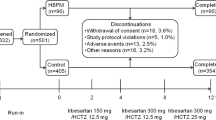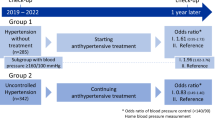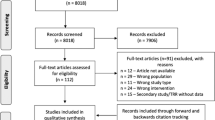Abstract
There is increasing awareness of seasonal variation in blood pressure (BP). In the present analysis, we investigated seasonal variation in the antihypertensive treatment effect of the irbesartan/hydrochlorothiazide combination in patients with stage 2 and 3 hypertension. The study participants were hypertensive patients enrolled in a 12-week therapeutic study. Antihypertensive treatment was initiated with irbesartan/hydrochlorothiazide 150/12.5 mg/day, with possible uptitration to 300/12.5 mg/day and 300/25 mg/day at 4 and 8 weeks of follow-up, respectively. The month of treatment commencement was classified as spring/summer (May to August) and autumn/winter (September to December). Of the 501 enrolled patients, 313 and 188 commenced antihypertensive treatment in spring/summer and autumn/winter, respectively. The mean changes in systolic/diastolic BP at 8 and 12 weeks of follow-up were greater in patients who commenced treatment in autumn/winter (−32.3/−16.5 and −34.2/−16.7 mmHg, respectively) than those who commenced treatment in spring/summer (−28.4/−13.9 and −27.1/−12.8 mmHg, respectively), with a between-season difference of 3.9 (95% confidence interval [CI], 1.4–6.4, P = 0.002)/2.6 (95% CI, 0.9–4.2, P = 0.002) mmHg and 7.0 (95% CI, 4.7–9.3, P < 0.0001)/3.9 (95% CI, 2.4–5.4, P < 0.0001) mmHg, respectively. Further subgroup analyses according to several baseline characteristics showed a greater between-season difference in the changes in systolic BP in patients aged ≥55 years than in those <55 years (n = 255, 12.6 mmHg vs. n = 246, 6.9 mmHg, P = 0.02), especially in patients who did not use antihypertensive medication at baseline (n = 94, 15.4 mmHg vs. n = 132, 5.4 mmHg, P = 0.006). In conclusion, there is indeed seasonality in the antihypertensive treatment effect, with a greater BP reduction in patients who commenced treatment in cold than warm seasons.
This is a preview of subscription content, access via your institution
Access options
Subscribe to this journal
Receive 12 print issues and online access
$259.00 per year
only $21.58 per issue
Buy this article
- Purchase on SpringerLink
- Instant access to full article PDF
Prices may be subject to local taxes which are calculated during checkout



Similar content being viewed by others
References
Stergiou GS, Palatini P, Modesti PA, Asayama K, Asmar R, Bilo G, et al. Seasonal variation in blood pressure: Evidence, consensus and recommendations for clinical practice. Consensus statement by the European Society of Hypertension Working Group on Blood Pressure Monitoring and Cardiovascular Variability. J Hypertens. 2020;38:1235–43.
Stergiou GS, Myrsilidi A, Kollias A, Destounis A, Roussias L, Kalogeropoulos P. Seasonal variation in meteorological parameters and office, ambulatory and home blood pressure: predicting factors and clinical implications. Hypertens Res. 2015;38:869–75.
Chen RJ, Lu JX, Yu Q, Peng L, Yang DD, Wang CC, et al. The acute effects of outdoor temperature on blood pressure in a panel of elderly hypertensive patients. Int J Biometeorol. 2015;59:1791–7.
Hanazawa T, Asayama K, Watabe D, Hosaka M, Satoh M, Yasui D, et al. Seasonal variation in self-measured home blood pressure among patients on antihypertensive medications: HOMED-BP study. Hypertens Res. 2017;40:284–90.
Wang Q, Li CC, Guo YF, Barnett AG, Tong SL, Phung D, et al. Environmental ambient temperature and blood pressure in adults: a systematic review and meta-analysis. Sci Total Environ. 2017;575:276–86.
Kollias A, Kyriakoulis KG, Stambolliu E, Ntineri A, Anagnostopoulos I, Stergiou GS. Seasonal blood pressure variation assessed by different measurement methods: systematic review and meta-analysis. J Hypertens. 2020;38:791–8.
Zheng S, Wang MZ, Cheng ZY, Kang F, Nie YH, Mi XY, et al. Effects of outdoor temperature on blood pressure in a prospective cohort of northwest China. Biomed Environ Sci. 2021;34:89–100.
Wang QZ, Gao CL, Liu HE, Li W, Zhao YY, Xu GR, et al. Hypertension modifies the short-term effects of temperature on morbidity of hemorrhagic stroke. Sci Total Environ. 2017;598:198–203.
Yu B, Jin SS, Wang C, Yan SC, Zhou X, Cui XM, et al. The association of outdoor temperature with blood pressure, and its influence on future cardio-cerebrovascular disease risk in cold areas. J Hypertens. 2020;38:1080–9.
Yang L, Li LM, Lewington S, Guo Y, Sherliker P, Bian Z, et al. Outdoor temperature, blood pressure, and cardiovascular disease mortality among 23 000 individuals with diagnosed cardiovascular diseases from China. Eur Heart J. 2015;36:1178–85.
Imai E, Abe K. Blood pressure drop in summer may cause acute kidney injury with irreversible reduction of glomerular filtration rate. Clin Exp Nephrol. 2013;17:1–2.
Huang JJ, Desai C, Singh N, Sharda N, Fernandes A, Riaz IB, et al. Summer syncope syndrome redux. Am J Med. 2015;128:1140–3.
Huang QF, Sheng CS, Li Y, Ma GS, Dai QY, Wang JG. Efficacy and safety of a fixed combination of irbesartan/hydrochlorothiazide in Chinese patients with moderate to severe hypertension. Drugs R D. 2013;13:109–17.
Zhang D, Huang QF, Li Y, Wang JG. A randomized controlled trial on home blood pressure monitoring and quality of care in stage 2 and 3 hypertension. Hypertens Res. 2021;44:533–40.
Zhang D, Huang QF, Li Y, Wang JG. Incident hyperuricemia in relation to antihypertensive therapy with the irbesartan/hydrochlorothiazide combination. Blood Press Monit. 2021;26:413–8.
Tu YK, Chien KL, Chiu YW, Ellison GTH. Seasonal variation in blood pressure is modulated by gender and age but not by BMI in a large Taiwanese population, 1996-2006. J Am Soc Hypertens. 2013;7:216–28.
Su D, Du H, Zhang X, Qian Y, Chen L, Chen Y, et al. Season and outdoor temperature in relation to detection and control of hypertension in a large rural Chinese population. Int J Epidemiol. 2014;43:1835–45.
Madaniyazi L, Zhou Y, Li SS, Williams G, Jaakkola JJK, Liang X, et al. Outdoor temperature, heart rate and blood pressure in Chinese adults: Effect modification by individual characteristics. Sci Rep. 2016;6:21003.
Narita K, Hoshide S, Fujiwara T, Kanegae H, Kario K. Seasonal variation of home blood pressure and its association with target organ damage: The J-HOP Study (Japan Morning Surge-Home Blood Pressure). Am J Hypertens. 2020;33:620–8.
Narita K, Hoshide S, Kario K. Seasonal variation in blood pressure: current evidence and recommendations for hypertension management. Hypertens Res. 2021;44:1363–72.
Sheng CS, Cheng YB, Wei FF, Yang WY, Guo QH, Li FK, et al. Diurnal blood pressure rhythmicity in relation to environmental and genetic cues in untreated referred patients. Hypertension. 2017;69:128–35.
Acknowledgements
The authors gratefully acknowledge the participation of the patients and the contribution of the investigators from 18 participating hospitals. For detailed information on the participating hospitals, please refer to reference [13].
Funding
The study was funded and sponsored by Sanofi China (Shanghai). YL and J-GW were also financially supported by grants from the National Natural Science Foundation of China (grants 81770455, 82070432 and 82070435), Ministry of Science and Technology (2018YFC1704902) and Ministry of Health (grant 2016YFC0900902), Beijing, China; from the Shanghai Commissions of Science and Technology (grant 19DZ2340200) and Health (“Three-year Action Program of Shanghai Municipality for Strengthening the Construction of Public Health System” GWV-10.1-XK05 and a special grant for ‘leading academics’) Shanghai, China; and from the Clinical Research Program, Ruijin Hospital, Shanghai Jiao Tong University School of Medicine (grant 2018CR010), Shanghai, China.
Author information
Authors and Affiliations
Corresponding author
Ethics declarations
Conflict of interest
J-GW reports receiving consulting and lecture fees from Novartis, Omron, and Servier. The other authors declare no conflicts of interest.
Additional information
Publisher’s note Springer Nature remains neutral with regard to jurisdictional claims in published maps and institutional affiliations.
Supplementary information
Rights and permissions
Springer Nature or its licensor (e.g. a society or other partner) holds exclusive rights to this article under a publishing agreement with the author(s) or other rightsholder(s); author self-archiving of the accepted manuscript version of this article is solely governed by the terms of such publishing agreement and applicable law.
About this article
Cite this article
Ye, XF., Huang, QF., Li, Y. et al. Seasonal variation in the effect of antihypertensive treatment with the irbesartan/hydrochlorothiazide combination. Hypertens Res 46, 507–515 (2023). https://doi.org/10.1038/s41440-022-01084-y
Received:
Revised:
Accepted:
Published:
Issue date:
DOI: https://doi.org/10.1038/s41440-022-01084-y
Keywords
This article is cited by
-
2023 update and perspectives
Hypertension Research (2024)
-
Management of seasonal variation in blood pressure through the optimal adjustment of antihypertensive medications and indoor temperature
Hypertension Research (2023)



